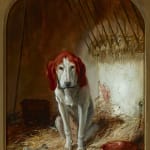Arthur Fitzwilliam Tait 1819-1905
The Hound, c. 1853
Oil on board
13 1/8 x 10 inches
33.3 x 25.4 cm
33.3 x 25.4 cm
Signed within painting (on bucket): AFT
Born in Liverpool, England, Arthur Fitzwilliam Tait immigrated to the United States and became one of America’s finest animal painters. He was primarily self-taught, although as a boy, he trained...
Born in Liverpool, England, Arthur Fitzwilliam Tait immigrated to the United States and became one of America’s finest animal painters. He was primarily self-taught, although as a boy, he trained as a lithographer for Agnew’s, an art dealer in Manchester, England. Tait also met and assisted George Catlin, who painted Native Americans, and this connection may have helped enhance Tait’s fascination with the American Wild West and sporting life.
In 1850, Tait traveled to the United States to pursue his interest in wildlife and hunting. The pastime of sport in America owed a great deal to its English forebear; however, in the United States the land was open to hunters of every social class, whereas hunting in English society remained the privilege of the aristocratic gentry. Moreover, America had long been viewed as a “hunter’s paradise,” and shooting was a favorite national pastime.1 Tait became a skilled woodsman and marksmen and applied that excellent first-hand knowledge to his paintings. Indeed, Tait was a careful and realistic observer of wildlife who adhered strictly to the English aesthetician John Ruskin's theory of "truth to nature" in art. Thus, it is not surprising that his animal paintings were hailed for their masterful realism. Furthermore, he captured the personalities of the animals, while maintaining this level of realism and never venturing toward cartoon.
In The Hound, Tait depicts a chained dog with such a plaintive expression that the viewer cannot fail to be moved by it. The late nineteenth century witnessed the emerging popularity of paintings devoted specifically to field and hunting dogs.2 This painting is accompanied by an original poem by C.D. Stewart, which reads as an ode to the faithful hound. Stewart alludes to the dog’s unfortunate captivity and seems almost to plead on his behalf, saying:
In every chase he won the race—
Where fox or stag was found—
Is’t fair to chain him thus, alone,
When chase is oe’r and game is won—
My brave and fearless hound?
Paintings and tales about hunting were extremely popular during the nineteenth century, and the rise of the publishing industry made them readily available to a growing middle class audience. In 1852, the publishing company Currier & Ives began reproducing color lithographs of Tait’s paintings, which helped popularize them immensely. Images such as this one were widely loved by the American public and continue to be highly sought after to this day.
1 Wendell D. Garrett, “Introduction: The Rise of Sporting Culture in America” in F. Turner Reuter, Jr., Animal & Sporting Artists (2008), p. ix.
2 William H. Gerdts, “Foreword: American Animal Artists” in F. Turner Reuter, Jr., Animal & Sporting Artists, p. xii.
In 1850, Tait traveled to the United States to pursue his interest in wildlife and hunting. The pastime of sport in America owed a great deal to its English forebear; however, in the United States the land was open to hunters of every social class, whereas hunting in English society remained the privilege of the aristocratic gentry. Moreover, America had long been viewed as a “hunter’s paradise,” and shooting was a favorite national pastime.1 Tait became a skilled woodsman and marksmen and applied that excellent first-hand knowledge to his paintings. Indeed, Tait was a careful and realistic observer of wildlife who adhered strictly to the English aesthetician John Ruskin's theory of "truth to nature" in art. Thus, it is not surprising that his animal paintings were hailed for their masterful realism. Furthermore, he captured the personalities of the animals, while maintaining this level of realism and never venturing toward cartoon.
In The Hound, Tait depicts a chained dog with such a plaintive expression that the viewer cannot fail to be moved by it. The late nineteenth century witnessed the emerging popularity of paintings devoted specifically to field and hunting dogs.2 This painting is accompanied by an original poem by C.D. Stewart, which reads as an ode to the faithful hound. Stewart alludes to the dog’s unfortunate captivity and seems almost to plead on his behalf, saying:
In every chase he won the race—
Where fox or stag was found—
Is’t fair to chain him thus, alone,
When chase is oe’r and game is won—
My brave and fearless hound?
Paintings and tales about hunting were extremely popular during the nineteenth century, and the rise of the publishing industry made them readily available to a growing middle class audience. In 1852, the publishing company Currier & Ives began reproducing color lithographs of Tait’s paintings, which helped popularize them immensely. Images such as this one were widely loved by the American public and continue to be highly sought after to this day.
1 Wendell D. Garrett, “Introduction: The Rise of Sporting Culture in America” in F. Turner Reuter, Jr., Animal & Sporting Artists (2008), p. ix.
2 William H. Gerdts, “Foreword: American Animal Artists” in F. Turner Reuter, Jr., Animal & Sporting Artists, p. xii.
Provenance
Private collectionPlease join our mailing list
* denotes required fields
We will process the personal data you have supplied in accordance with our privacy policy (available on request). You can unsubscribe or change your preferences at any time by clicking the link in our emails.



